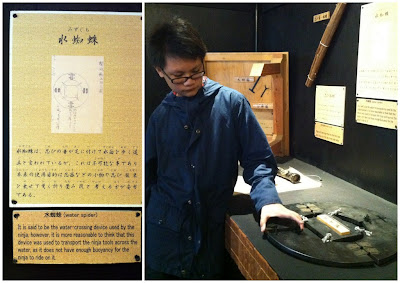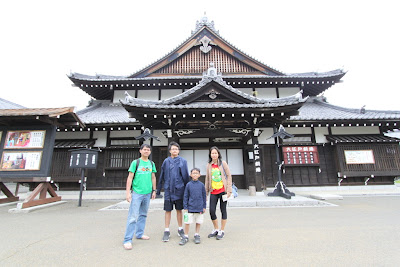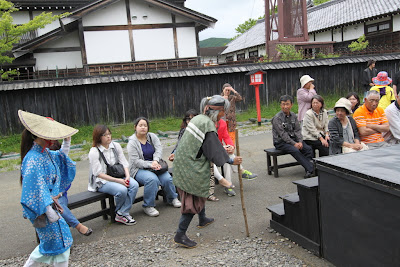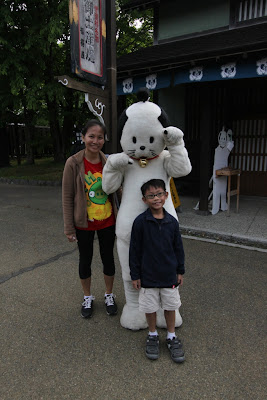Got up early in the morning for our Japanese-style breakfast which was included in the room package. We dressed up in our yukatas and headed to the first floor dining area, as advised last night by our friendly host.

just across the hall was the women's bath
We all looked forward to the breakfast, as well as the last onsen bath before we check out.

This was what welcomed us (aside from our hospitable host) in our private dining area.
I was expecting us to be seated on the floor (traditional Japanese way) but maybe they thought having chairs would be more comfortable :)


our sumptuous traditional Japanese breakfast
That's tomato and veggie salad, seaweed, egg in some sauce, tofu, salmon and egg, ginger, some sort of sweet and tea.

smelling and tasting what's been prepared for us
it was heaven for Kelvin as he tasted each and every item
in a cute ceramic Japanese house container
veggies, anyone?
our picky eater couldn't seem to find anything that he was interested in.....
so he made his own breakfast. He saw the Japanese seaweeds and thought of his own DIY sushi. Daddy served him rice then he prepared the sushi on his plate. Yum!
our tummies were satisfied
Next on our agenda - onsen! It was open until 9am (before cleaning) so we had to rest for a while after breakfast (rule: no onsen immediately after meal), then head back to the onsen for a quick dip and a relaxing morning before we venture into our adventures in Noboribetsu.
Perfect way to spend time relaxing and reflecting.
while the boys were just on the other side of the bamboo walls, having a time of their lives.
They had the place all by themselves (thank goodness, as they were quite noisy). The boys really enjoyed this experience, although they did have some apprehensions last night as they were not used to going to a public bath butt-naked. The temperature of the onsen was also intimidating at first. But they adjusted quite fast.
refreshed, revitalized, ready for another road trip
our room for the past night
each one of us had to wear these while in the hotel
farewell, Sanseikan! It was indeed an unforgettable experience, even if it's just one night.
The boys loved the futon beds and the onsen and the yukatas and the food.
We bid goodbye to our host and drove off to the nearest attraction.

our Noboribetsu map
I didn't include Jigukudani (Hell Valley) in our itinerary as we've already seen almost the same environment in New Zealand. But hubby had another thing in mind. So we followed the signs and got ourselves ready for what "hell valley" had in store for us.
Jigukudani or Hell Valley is the main source of Noboribetsu's hot spring waters. It has hot steam vents, sulfurous streams and other volcanic activity. There was a designated parking lot (the official one for this tourist attraction) for 410 yen which can also be used in the parking lot at Onoyuma. They also gave us maps.
our first glimpse of Hell Valley
although there were several steam vents, the area didn't feel hot at all....
....but the smell??? What do you expect from sulfur?
Ira couldn't take the smell that he covered his nose for most of our time there.
He wanted to go back to the car and drive far, fast! But we told him he would get used to it after sometime (which didn't really happen for him).
there were several walkway / paths that brought visitors closer to the vents
this one had a hole at the end of the path, with hot/boiling/steaming water in it
the toilet had the heads of the "demons" who were said to be watching this area
a favorite photo op spot for tourists in large groups
This was just across the parking lot for tour buses.
We didn't go to the farther end of the path as Ira really couldn't take the smell. So we decided to walk back to the carpark and drove to Onoyuma where there was a lake (of hot steaming water nonetheless).
about 5-10mins drive
only Kelvin and dad went out to view the lake.
Ira and I were left in the car as the little one really cannot be convinced
to step out and have a look at the lake.
our little boy inside the car, covering his nose from the nasty jigukudani sulfurous smell
some tourists actually went to this place by foot from Jigukudani. We thought they were just kidding when they told us it was a few minutes walk from the Jigukudani carpark.
So that's our nature adventure in Noboribetsu. Now let's head to our back-to-Edo-period experience at Jidai Mura.
Noboribetsu Date Jidai Mura (Noboribetsu Date Historical Village) is an authentic reproduction of an Edo period ( 1603-1867) village. During this period, Japan was closed to the rest of the world, but its culture and economy flourished (internally). It's really like stepping back in time when there were ninjas, shoguns, and a whole lot more.
Noboribetsu Date Jidai Mura
53-1 Naka Noboribetsu Cho
Noboribetsu Shi Hokkaido, Japan 059-0463
Phone: 0143-83-3311
Entrance fee: Adults 2900yen / children (6-12yrs) 1500yen / toddlers 600yen
Parking fee: 500 yen (car)
Opening hours: April 1 - Oct 31 9am-5pm / Nov 1- Mar 31 9am-4pm
Website: edo-trip.jp/en
Here's how we enjoyed our trip to Ninja Land (and more)....
can't decide whether we should wait for the other tourists to leave so we could take a photo with the "samurai / shogun" or to go inside and do the photo op later before we leave the park.
the map of Jidai Mura village, which was very helpful in exploring the themepark grounds
at Merchant's Lane
as the name suggests, this place was lined up with different shops selling food and souvenir items. The old wooden houses presented an Edo-esque atmosphere.
the boys were "stranded" at this shop, window-shopping for toy katanas, shurikens,
and other ninja stuff
classroom setting
Our exploration of the Ninja Resource Centre - exhibition of actual tools, swords, Shuriken, and other items that were used by the Ninja.
"water spider" - was supposed to be a water-crossing device by ninjas.
We've watched how this was disproved by Myth Busters though.
Kelvin trying on the "shukou" - an iron covering for the back of the hand and wrist used to protect from the sword attack and to attack the enemy by smacking their face. Sounds brutal!
Ira in shuriken world. You can even try them (samples) on the wooden post display. They do work!
ninja gimlet - used to pry open doors
iron tools and colored rice
Ira even got to try climbing the ninja ladder. It was pretty difficult to do so.


behind us - the Matsuga Pond and a small temple
located in the middle of the village
Kuma-san Lodge - a reconstruction of typical Edo living quarters. This place (made up of several rooms with open windows/doors) gave us an idea of how common people lived during that time.
At the side of the main entrance of the "village" was a barber shop.
getting in line for a haircut? Edo style?

we're ready to walk down memory lane

Photo #2: People in Nagaya: E-Rosoku-ya (candle maker). Candles were high class items during Edo Period. The woman is doing piecework of painting flowers on candles at home. Because of cold weather and non-flowering winter, people in Sendai used to offer these candles (instead of living flowers) to Buddha.
Photo #3: People in Nagaya: Horimono-shi (engraver or tattoo artist). Tattoo art was fashion among Edo ordinary people.
Photo #4: Ronin (masterless samurai). Samurais who lost their jobs and residences as a result of destruction or reconstructing of their master's house. This Ronin is making a Japanese umbrella, pasting the bamboo framework with paper, which was one of the most popular piecework in Edo.
Photo#1: Shamisen-Shisho (Shamisen instructor). Shamisen is one of the Japanese instruments. Learning Shamisen during that time was popular.
Photo #2: Sakana-ya (fishmonger).
Photo #3: Shitate-ya (tailor). Those days, many women made their own kimonos.
Photo #4: Kanpo-uri (pharmacist). Kanpo (the knowledge of herbal medicine which was imported from China and evolved in Japan) was at its peak in Edo period. The job of a Kanpo-uri was to mix herbs and make the best medicine for his patient.
need I say what this was?
helping out a villager in her laundry duties
At the Practice Dojo, children (and even adults) can train to become ninjas.
one can throw fighting stars or shoot arrows, or play games such as quoits and bean bag toss
A maze full of tricks and traps. We were ready to face them all.
There was an inclined floor which created an illusion (or so we thought) that it was moving.
But we sort of felt the house was really moving because the force of us falling to the other side of the room was so strong, it couldn't be just because of the inclined floor! Everyone who went in were shocked to find themselves "falling" to the other side of the room. There were also secret door and passages to nowhere. It was quite scary at times because it was dark and all of a sudden the room has inclined floors so we would slide from one side to the other. But it was fun! Here were some of the snapshots inside the Ninja Maze.
the first of a few inclined floors inside the house
Kelvin on the right side of the room, which was the "elevated" side of this room
staircase to nowhere
what's the surprise behind the door?
another inclined floor, walking up to go to one of the rooms
our fellow visitors scrambling to keep their balance as they get to the exit
Phew! We made it out, safe and sound....
thinking whether we would go back to the maze again....
in front of the O-Edo Theatre, but not yet time for the show
We walked towards the Ninja Castle, open on summer only, where there was an outdoor samurai and ninja show.
Ninja Castle shows from 10:45-11am and 12:55-1:10pm
this was the first act,
a guy holding a bunch of sticks (something like a wooden placemat to put it simply)
and turning it into different shapes as he walked around the stage singing a song
(I think he was telling a story about something, can't really understand as it was in Japanese)
the first act (I think it was the introduction of the whole story) was followed by the entrance to the stage by these 2 characters (grandpa and granddaughter?)
an actor flying in to the stage
as you can see, we were that CLOSE to the stage
- first row on the side (an elevated audience seat)

samurai action right before our eyes

the only female character on stage, and the villain at the centre

After all the action, we could feel our tummies grumbling and so we walked back to the Merchant's Lane where we saw some interesting food on our way to the Ninja Castle.
while waiting for our lunch, father and son were measuring their hands. Kelvin has grown so fast that his hand is now as long (or should I say slightly longer) than his dad's!
With tummies full, we were ready to explore the rest of the village.
but first, toilet break at one of the kawayas
at the bridge in Matsuga Pond
just outside the O-Nyako Cat Temple
Just next to the Cat Temple was the House of Ghosts and Monsters. At first, Ira didn't want to go inside as he was scared to see what monstrous or ghostly figures they had inside. But we were able to convince him, and we still had a few minutes to spare before the start of the next show.

It wasn't that scary after all...
pretending to be scared here
passed by one of the actors in the Ninja House as he prepared for their next show
We walked back to the Japanese Culture Theatre in time for the Oiran Show at 2:20pm).
Oiran Show times:
10:10-10:35am
12:10-12:35pm
2:20-2:45pm
4:20-4:45pm
The story depicted the Edo social life: the flashy Oiran concubines, the merrymaking, the spectacle. "The Oirans were top-ranked courtesans at Yoshiwara, the official red-light district. It’s believed that there were several thousands of courtesans at the golden age, but only a few of them could be “oiran”, who has excellence at arts and cultures not only at their beauty. “Oiran Docyu”, a procession of an oiran and her attendants, was a good and rare opportunity for the common people to see her who was beyond their reach. "
The story teller told us what was going to happen and what we were supposed to do after the showed. They passed us small white papers before the start of the show. Unfortunately, we didn't understand what we were supposed to do with them! We observed though that some of the visitors threw some of the papers with something inside them. Hmmmmmm...
The story teller told us what was going to happen and what we were supposed to do after the showed. They passed us small white papers before the start of the show. Unfortunately, we didn't understand what we were supposed to do with them! We observed though that some of the visitors threw some of the papers with something inside them. Hmmmmmm...
We were among the big group of people who came in to watch the show. There were even a few visitors who came from Singapore. That afternoon, we were the "millionaires" of the recreation of Edo period - who watched the glamourous Oiran show.
2 top photos were the "assistants" of the main character
bottom left photo: the host/narrator of the show.
She introduced what the show was all about (of course, mainly in Japanese).
She tried as best as she could to insert some English from time to time. She was funny.
bottom right photo: the star / main attraction
one person from the audience was selected (more like volunteered by his peers) to be the guest of honor in the show (the shogun). He was from Singapore, too!
The main star of the show moved very elegantly, dancing around as she entertained the "shogun". Her movements were so fluid and her voice was so high pitched. We were totally captivated by her.
After the show at the Culture Theatre, we walked back to the O-Edo Theatre for a show that was said to be popular among children and adults. It was the Nyanmage's funny theatre and they only perform during summer, so definitely came at the right time. Although, I'm sure the boys would have appreciated the exciting samurai show during winter. The show started at 3pm, which gave us enough time to walk from the Culture Theatre to the O-Edo Theatre.
Nyanmage is a mascot = a cat that has a shogun hair do of sorts.
The entire show was in Japanese so we couldn't really fully understand what was happening on stage. We only tried to understand through context. It was funny though (watching their actions). Ira and I were so into the show, while Kelvin and dad has other things in mind. Ira loved Nyanmage the mascot. And I liked this cute guy who was sort of like the shogun in the show (he is the guy standing on the right in the photo below).
Ira loved the mascot so much that he watched the entire show and laughing and giggling at the same time. The two of us talked about the show on our way out trying to see if we had the same story in mind.
group photo with the cast at the end of the show.
I initially planned to have my photo taken with the cute guy, and Ira couldn't wait to stand beside Nyanmage. So we waited for our turn and all of us gathered around together with the cast for this group photo. Unfortunately, I ended up standing beside the mascot but far from cute guy!
Next show was at 3:40pm, at the Kasumi Ninja House, which was just almost across the street. The cast of characters were outside welcoming the visitors into the show.
we stopped by for a photo with this ninja
one of the main characters at the show
On our way inside, we were again handed with white papers. We realized his was to be used for ohineri - coins wrapped in paper which audiences were supposed to throw at the stage after superb performance as tip for the actors. This time around we were prepared to toss them to the stage (Kelvin was eager to do so). Since this was the last show we were watching, we prepared the ohineri before the end of the show.
some snap shots of the action on stage
If you notice, some of them were the same characters in the show at the Ninja Castle earlier on.
at the steps going up to the Katakura Kojurou Mansion
at the main entrance
Kelvin entering the gates to the mansion
here's some background info about the place

the main residence with a garden located on the right
this was prominently displayed near to the entry door,
to welcome visitors to the house of samurai (i guess)
The following were the different exhibits inside the mansion.
samurai swords, katanas and how they were made
as we stepped out of the main residence, we headed to the garden

guess what we found inside this lovely garden???
I asked hubby if this was the famous sakura of Japan. We didn't really expect to see any trees in bloom as we were a few weeks late. But we looked closely and it seemed we were in luck!
one sakura bloom for confirmation (and as a souvenir!)
I plucked one flower from the tree and brought it to the next building where we could ask someone to confirm if it was sakura. I've read from online articles that in Hokkaido the sakuras bloom a bit later. But we didn't expect to see them here. When passed by the Practice Dojo, I stopped by to ask one of the attendants if they have sakura trees here. She smiled, led us to the nearby shrine (beside the Fire Watchtower) and said "sakura".
in front of the shrine where the Sakura tree blooms
the pathway at the side of the shrine as well as in front of the shrine were filled with sakura petals
One item ticked off our bucket list!

final minutes before we leave the theme park
stopping by the shops yet again as Ira plays with a samura sword
and what do you know?
Ira had another photo op with Nyanmage just before we exit the gates
Look at that smile on his face. He asked if he could bring him back home.
Well, he was too big for handcarry.
goodbye, Jidai Mura. It was a real treat for all of us to be able to have a glimpse at the life of people during the Edo Period. We laughed, we applauded, we took part in the shows. I'm glad I've included this place in our destinations to visit in Hokkaido. It was all worth it.
Sayonara!
Off we were to our final stop for the day, Lake Toya. It was about 60kms, a good 1.5hr drive. We didn't need to rush. We were on schedule. We arrived at Hotel Grand Toya at around 7pm. We could see that the hotel was close to the lake and we said we could take a walk there that night. We knew it was a great location. But we didn't realize how much value for money we got until we entered our hotel room (another Japanese style accommodation).
Hotel Grand Toya
Toyako Onsen 144 Toyako 049-5721
Phone: +81-14-275-2288
Email: info@grandtoya.com
Japanese style quad w/ shared bathroom = 14,400 yen (1night)
excluding 150 yen per person per night tax
Booked thru booking.com
(+) option to have Japanese style accommodation
(+) great location (lake front, overlooking Mt Yotei)
(+) free parking
(+) close to eating places

we didn't really expect to have full view of Mt Yotei (Hokkaido's Mt Fuji) from our hotel room

getting the most of the light that we had left that night
But wait, that was not all. The receptionist informed us during check in that there were fireworks display by the lake at around 8:45pm. And we could see all of this just staying by our hotel room! We became more excited to see what this fireworks display was all about. We went out to have dinner (ended up at seicomart again, and bought ready-to-eat packed meals plus snacks for tomorrow's road trip to Hakodate) and rushed back to the hotel to prepare for the fireworks.
Of course, hubby was not contented to just view the fireworks display from our window. He and Kelvin went down, where they could be closer to all the action. It got too cold that night that Kelvin had to wear a bonnet and a pair of gloves.
These were the shots taken from the fireworks display that night. Apparently, the fireworks came from a boat (or boats) sailing along the lake. Here were the photos taken by hubby from along the lake.
Ira and I enjoyed watching them from the convenience of our hotel room window.
It was really such a nice treat to be able to watch this while relaxing at our hotel room.
hubby and Kelvin stayed by the lake for a few more minutes
to take this photo of the stars in the sky
by the time dad and Kelvin went back to the room, I have already fixed our futon beds complete with bed covers. And I have also had Ira dressed up in his kiddy yukata. The receptionist was kind enough to give us a smaller size (the first one that really fit him well).
And what other better way to end our adventure-filled day but to soak in hot, relaxing onsen before we finally retire to bed. No photos this time around.






























































































































Wow! I've been wanting to go back Japan for so long, will try to stay this area next time of given the opportunity. Nice shots ;-)
ReplyDeleteThanks! Shots courtesy (mostly) of hubby.
DeleteYes, you should! Hokkaido is really highly recommended. A mix of city life and nature / suburban life. We definitely would want to go back here, too, if given the chance (and budget). We will probably explore the northern part of the island, as well as other parts of Japan.